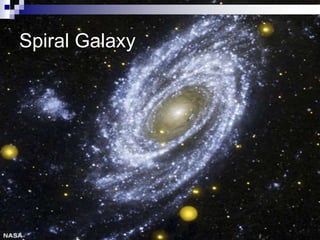Thestarsandthegalaxiesintheuniverse
- 1. THE STARS AND THE GALAXIES IN THE UNIVERSE
- 2. THE SUN The Sun is the closest star to Earth and is the center of our solar system. A giant, spinning ball of very hot gas, the Sun is fueled by nuclear fusion reactions. The light from the Sun heats our world and makes life possible. The Sun is also an active star that displays sunspots, solar flares, erupting prominences, and coronal mass ejections. These phenomena impact our near-Earth space environment and determine our "space weather."
- 3. Charateristics of the Sun Size: 1 392 000 km in diameter Mass: 1.98 x 10³° kg Density: 1400kg/m³ Surface Temperature:5500 °C– 6000 °C
- 4. The Structure of Sun
- 5. The Stars
- 6. The Various Types of Stars Stars are classify according to its size, brightness, surface temperature and colour. There are four main groups of stars, namely -White dwarf -Neutron stars -Giants -Super Giants
- 7. White Dwarf
- 9. Giant Star
- 10. Supergiant Star
- 11. The Formation of Stars Stars are formed within large clusters of dust and gases called as nebulae. Due to the force of gravity nebula collapses and spin. The spinning clouds pull in more hydrogen gas over millions of years. Collisions occurred between nebula and hydrogen atoms. Hydrogen atoms combine to form helium atoms, releasing a large amount of heat and light.
- 12. The Death of Stars The lifespan of Star is determined by the original mass of the Star. The Star will become either a white dwarf, neutron Star or black hole when it dies.
- 14. THE FORMATION OF STAR
- 15. THE GALAXIES A Galaxy is a group of stars held together by gravity. There are billions of stars in a Galaxy. The main three types of Galaxies are - Spiral Galaxy - Elliptical - Irregular
- 16. Spiral Galaxy
- 18. Irregular Galaxy
- 19. The Milky Way It is the name of Galaxy. It has spiral shape. It contains 200 billions stars. Sun is one of the star in Milky way.
- 20. THE UNIVERSE The Universe contains billions of galaxies with each galaxy containing billions of stars. Universe is always evolving. Everything that exits in the universe is not permenant. New stars are being born while existing stars will eventually die. MAIN MENU
- 21. THE UNIVERSE The Universe contains billions of galaxies with each galaxy containing billions of stars. Universe is always evolving. Everything that exits in the universe is not permenant. New stars are being born while existing stars will eventually die.
- 22. A PoemFor TheUniverse Up the sky I share I lookup and wish I’m there, Beautiful andrare





















